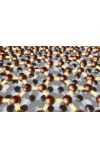
08 Jul 2013 01:54:44
Stuff Matters can be seen as a book in the line of JE Gordon's Structures: Why Things Don't Fall Down and The New Science of Strong Materials or Why You Don't Fall Through the Floor – 1970s classics still in print and cited in Miodownik's further reading list. But times have changed. Gordon was a great populariser who enlivened his tales of materials with stories of yachting and classical Greece, his other great passions; he even gave us the basic equations of materials science. Miodownik has no equations, and his points of reference are often from pop culture and consumerist lifestyles; but there are also many nuggets gleaned from history.
I half expected a parade of hi-tech – invisibility cloaks and all – but wisely, he mostly plumps for the longstanding and already humanised materials – steel, glass, paper, porcelain – with plastics, concrete and carbon fibre composites as the representatives from the 20th century. The new age is represented by aerogels, graphene and bionic body replacements. The odd man out is chocolate, which admittedly has an intriguing technological back-story, but it's there essentially because Miodownik is a chocoholic.
He's pretty enthusiastic about all the materials he writes about. Most are useful and aesthetically and culturally pleasing, but he celebrates aerogels – which struggle to find users other than Nasa – for their sheer physical wondrousness: silica aerogel is a spectrally blue substance that seems to blend into the air (it is blue for the same reason the sky is blue – it scatters light), weighs barely more than air (it is 99.8% made of the stuff), and is the world's best insulator: a flower placed on an aerogel block is untouched by a Bunsen burner roaring away beneath it, while graphene aerogel is the world's lightest solid.
Miodownik tells a good story: in the case of plastics he even turns in a film script to make the point that they are worthy materials and not, as the 1960s derogatively had it, "plastic, man". At the chapter's close, he lists a few iconic examples: nylons, vinyl records, silicone. Above all, he celebrates celluloid as the plastic with the biggest cultural impact: film would have been impossible without it and Miodownik weaves a tale, beginning with the Wild West days of late-19th-century invention, of celluloid's explosive nature (it is a close chemical cousin of guncotton – nitrocellulose or flash paper).
Also enthralling are the accounts of craft inventions before the scientific age. Until the industrial revolution, only the Samurai possessed the secret of creating hard, sharp steel. The essential factor, the carbon content, was known to no one, east or west, but the Japanese found an empirical way of selecting the sharpest steel. Porcelain was a most unlikely invention: totally unlike standard pottery, it achieves its amazing toughness and bone-like translucency through an unlikely combination of white clay, feldspar and quartz heated to 1,200C. Until 1704 only the Chinese had the secret. But Miodownik suggests that the Chinese disdain for glass contributed to their missing out on the scientific revolution. Glass is the material of microscopes, telescopes and chemical apparatus; science can't be done without it.
Miodownik writes of his own involvement with materials: he traces his interest back to the shocking impact of a razor blade when he was slashed by a stranger on a London tube station. Other close encounters are more benign: he watches the Shard rise near his home and counts the truckloads of concrete going in (700); photographic paper has him musing on his refugee father's German ID card and the uncanny authority of marks on paper; while porcelain leads to reflections on his parents' wedding teaset.
His final chapter explains some of the science (minus equations) behind materials: that it is all a matter of Russian-doll structural hierarchies stretching up from the tiny atoms, though nano, micro and miniature structures until we have the things we can see and handle. How these unseen layers create the familiar properties of glass, porcelain and stainless steel is deftly explained. Anyone not already a materials buff will learn a lot, but although Miodownik is good at explaining why we take some materials to our hearts (diamonds for instance) and not others (glass is the architects' favourite but it isn't exactly lovable), some puzzles remain. Why are some inventors famous while others languish in permanent obscurity? Harry Brearley, for instance, who invented stainless steel in 1913. It's hard now to imagine a world without stainless steel, but few have heard of Brearley.
A materials science book wouldn't be complete without a British technology story of success and failure. Carbon fibre composites, which currently make up around 50% by weight (nearer 80% by volume) of a Boeing Dreamliner or Airbus 350, and dominate sports equipment from tennis to Formula 1, were invented in 1963 by the Royal Aircraft Establishment at Farnborough (now privatised, of course, as QinetiQ). The missing coda in Miodownik's account is that, although carbon fibre composites were successfully commercialised, notably by Rolls-Royce and Courtaulds, by the 1990s only one small UK firm, RK Carbon Fibre, at Inverness, remained. And that was taken over by the global SGL group in 1997.
But the tide may be turning, and if it does, Miodownik, as director of the Institute of Making, will be riding it. If anybody can put real impetus into George Osborne's call for a "march of the makers" it must be him: the very model of a modern materials man.

